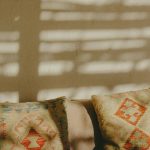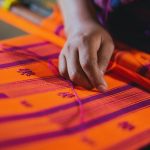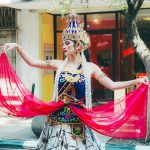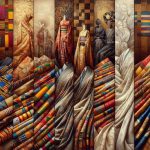You’ll find batik fabric’s history rooted deeply in Indonesia, where artisans used wax-resist dyeing to create intricate designs tied to spiritual and social meanings. Early motifs reflected nature, myths, and social status, with some reserved for royalty or ceremonies. Over time, batik evolved, blending tradition with modern styles and spreading globally. Its vibrant patterns now inspire fashion worldwide. If you explore further, you’ll uncover how batik’s cultural significance continues to thrive through preservation and innovation.
Table of Contents
Key Takeaways
- Batik originated centuries ago in Indonesia, serving as fabric decoration and expressing identity and social status.
- Early batik designs featured symbols of nature, spirituality, and local myths integrated into ceremonies and daily life.
- Traditional batik uses natural fabrics, canting tools, and wax-resist dyeing techniques requiring skilled craftsmanship.
- Batik motifs evolved by blending ancient symbols with modern influences, influencing African textiles and Western fashion.
- Preservation efforts include artisan training, cultural festivals, and supporting local makers to maintain batik’s heritage.
Origins of Batik in Indonesia
Batik in Indonesia traces back centuries and holds deep cultural significance. When you explore its origins, you’ll find it began as more than just fabric decoration—it became a way to express identity and social status.
You’ll see that early batik designs often featured symbols representing nature, spirituality, and local myths. As you learn more, you’ll realize that batik was deeply integrated into ceremonies and daily life, reflecting your community’s values.
It wasn’t just art; it was a language woven into cloth. Over time, you’d notice that different regions developed unique patterns, showing how batik evolved alongside your culture.
This rich history makes batik a treasured heritage, connecting you to Indonesia’s past in a meaningful way.
Traditional Techniques and Materials
Mastering traditional techniques and selecting the right materials are essential steps in creating authentic batik fabric.
Mastering traditional methods and choosing quality materials are key to crafting genuine batik fabric.
You’ll start by choosing natural fabrics like cotton or silk, which absorb wax and dye well. The key tool you’ll use is the canting, a small copper pen that lets you apply hot wax precisely to the fabric. Alternatively, you might use a cap, a copper stamp for repeating patterns quickly.
As you apply wax, it resists dye, preserving the original fabric color where it’s applied. You’ll then dip the cloth into dye baths, repeating the waxing and dyeing process for multiple colors.
Finally, you’ll boil the fabric to remove the wax, revealing intricate designs. This hands-on process requires patience and skill to produce true batik artistry.
Symbolism and Cultural Meaning
Many batik patterns carry deep cultural meanings that go beyond their visual appeal. When you look closely, you’ll find each motif tells a story or represents values like fertility, protection, or social status.
For example, certain designs were once reserved for royalty, symbolizing power and nobility. Others convey spiritual beliefs or celebrate nature’s beauty, such as flowers, animals, and mythical creatures.
Wearing batik isn’t just about fashion—it’s a way to connect with heritage and express identity. You’ll notice that specific patterns are chosen for ceremonies, weddings, or rites of passage, highlighting their significance in community life.
Understanding these symbols helps you appreciate batik as a living tradition, rich with meaning woven into every thread.
Batik Beyond Indonesia: Global Influences
You’ll see batik’s vibrant patterns have traveled far beyond Indonesia, influencing African textile traditions with their bold designs.
You can also spot batik’s impact in Western fashion, where designers incorporate its unique motifs into modern styles.
Let’s explore how these global connections have shaped batik’s evolving story.
African Batik Traditions
How did batik, originally rooted in Indonesian culture, find vibrant expression across Africa? You’ll discover that African batik traditions emerged through historical trade and cultural exchange, especially via Dutch colonial routes linking Indonesia and Africa.
As you explore African batik, you’ll notice bold, colorful patterns reflecting local symbols and stories, differing from the more intricate Indonesian motifs. In West Africa, countries like Nigeria and Ghana adopted batik techniques, using wax-resist dyeing to create fabrics for ceremonies and daily wear.
You’ll also see how the process adapted to local materials and tastes, blending African aesthetics with batik’s technical roots. This fusion transformed batik into a dynamic art form that resonates deeply with African identity, showing how a traditional craft can evolve across cultures.
Batik in Western Fashion
While African batik traditions highlight the fabric’s adaptability and cultural resonance, batik’s appeal has also stretched far beyond its origins and the African continent.
When you explore Western fashion, you’ll see how designers embraced batik’s unique patterns and vibrant colors, incorporating them into modern clothing lines. You’ll find batik-inspired pieces in everything from high-end runway collections to casual streetwear.
This global influence shows how batik transcends cultural boundaries, blending traditional techniques with contemporary styles. As you wear batik in a Western context, you participate in a rich exchange of creativity and heritage.
This fusion not only honors batik’s past but also propels it into new fashion frontiers, making it a dynamic and enduring textile worldwide.
Evolution of Batik Designs Over Time
You’ll notice that batik designs started with traditional motifs deeply rooted in local culture and symbolism.
Over time, these patterns have evolved, blending old styles with modern influences to create fresh adaptations.
Let’s explore how these changes reflect both history and innovation in batik art.
Traditional Motifs Origins
Many traditional batik motifs trace their origins to ancient symbols and cultural stories passed down through generations. When you explore these designs, you’ll find they often carry meanings tied to nature, spirituality, and social status. For example, the parang motif symbolizes strength, while the kawung represents purity. Each pattern connects you to the culture’s values and history, embedding stories in fabric. As you look closer, you’ll notice how these motifs reflect the environment and beliefs around the artisans. Here’s a quick look at some iconic traditional motifs:
| Motif | Symbolism | Meaning |
|---|---|---|
| Parang | Swords and waves | Strength and courage |
| Kawung | Palm fruit | Purity and harmony |
| Ceplok | Geometric flowers | Beauty and balance |
These motifs keep the heritage alive through your hands.
Modern Design Adaptations
Traditional batik motifs carry rich stories and symbolism, but batik fabric hasn’t stayed frozen in time.
Today, you’ll find modern batik designs blending classic patterns with contemporary art, reflecting current trends and individual creativity. Artists experiment with bolder colors, abstract shapes, and innovative techniques, making batik more versatile for fashion and interior design.
You can see batik on everything from casual wear to high-end collections, showing how this traditional craft adapts to modern tastes. By embracing new materials and digital printing methods, designers guarantee batik remains relevant and accessible worldwide.
When you wear or use modern batik, you’re participating in a living tradition that honors the past while welcoming fresh ideas and styles.
Batik in Modern Fashion and Art
Although batik has deep historical roots, it continues to inspire designers and artists worldwide today. When you wear batik, you’re not just embracing vibrant patterns; you’re connecting with a rich cultural heritage that’s been reinterpreted in countless ways.
Modern fashion designers incorporate batik into contemporary styles, blending traditional motifs with innovative cuts and fabrics. Artists use batik techniques to create unique visual expressions, pushing boundaries beyond clothing into installations and mixed media art.
Batik thrives as designers and artists blend tradition with innovation across fashion and mixed media art.
You’ll find batik on runways, in galleries, and on everyday streets, proving its timeless appeal. By choosing batik, you support a living art form that evolves while honoring its origins.
It’s a vibrant, creative statement that bridges the past and present in your wardrobe and surroundings.
Preservation and Revival of Batik Traditions
As batik faces the challenges of modernization and mass production, communities and artisans actively work to preserve its authentic techniques and cultural significance.
You can support these efforts by understanding how traditions are kept alive:
- Education and Workshops: You can participate in or promote classes where artisans teach traditional batik methods, ensuring new generations learn the craft.
- Cultural Festivals: By attending or organizing events that celebrate batik, you help raise awareness and appreciation for its heritage.
- Supporting Local Artisans: Buying directly from skilled batik makers encourages sustainable practices and keeps the craft economically viable.
Frequently Asked Questions
How Long Does It Take to Make a Single Batik Fabric Piece?
It takes you several days to weeks to make a single batik fabric piece, depending on complexity. You’ll apply wax, dye layers, and repeat processes carefully to create those intricate, beautiful patterns by hand.
What Are the Environmental Impacts of Batik Production?
Imagine dye runoff like spilled paint in a river—it harms aquatic life. You’ll find batik’s traditional methods use natural dyes, but some modern chemicals can pollute water and soil if you don’t manage waste carefully during production.
Can Batik Fabrics Be Machine-Washed Safely?
You can machine-wash batik fabrics, but you should use cold water and a gentle cycle to protect the colors and patterns. Avoid harsh detergents and always air dry to keep your batik looking vibrant longer.
What Types of Clothing Are Commonly Made From Batik Fabric?
Did you know over 70% of traditional Indonesian garments use batik fabric? You’ll often find batik in dresses, shirts, skirts, and scarves, making your outfit vibrant and culturally rich. Don’t hesitate to wear it proudly!
Are There Synthetic Alternatives to Traditional Batik Dyes?
Yes, you can use synthetic dyes as alternatives to traditional batik dyes. They offer brighter colors and faster processing, but they might lack the natural, earthy tones and unique variations that natural dyes provide in batik fabric.
- Tetron Fabric for Marine Applications: Durability and Use Cases - June 18, 2025
- Tetron Fabric for Outdoor Furniture: Weather Resistance and Care - June 18, 2025
- Tetron Fabric for Wall Coverings: Style and Application Tips - June 18, 2025







